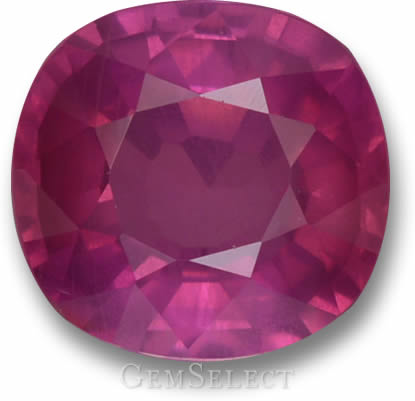Untreated Gemstones
It's a fact of life in the gemstone industry that many gems are treated. The most common form of treatment is heat treatment, which is applied routinely to ruby and sapphire, and to other gems such as tanzanite, blue zircon and blue apatite. Some gems, such as blue topaz, are irradiated to produce their distinctive color; in fact it's virtually impossible to buy a blue topaz gem that has not been irradiated. Other gems, such as emerald, are treated with oils or resins to fill fractures. More recently, we've seen heat treatment with beryllium diffusion for yellow and orange sapphires, and fracture-filling with lead glass for African rubies. Sometimes it seems like the gemstone world is awash with gem treatments.

Untreated African Ruby
The idea of treating gems is hardly new. Pliny's Natural History, the compendium of knowledge from ancient Rome written in the first century A.D., discusses a range of techniques for altering gems, including heating, oiling, dyeing and the use of foil backings and coatings. Some of those ancient techniques were undoubtedly deceptive, but nowadays, gem treatments are just a way for the industry to meet the global demand for gemstones in the face of very limited supply.
Even with the prevalence of gem treatments, there remains a wide selection for buyers seeking untreated gems. While rare untreated sapphires or rubies may come at a high price, there are other gemstone varieties that possess excellent characteristics like hardness, durability, brilliance, and clarity, all while boasting outstanding natural color. These untreated gems can be purchased with assurance of their authenticity. Here are our top recommendations for untreated gem varieties:
|
 Many gem dealers consider spinel to be the finest untreated gem variety available today. It has excellent gemstone characteristics, such as a hardness of 8 on the Mohs scale, and excellent clarity and dispersion (fire). Spinel has often been confused with fine ruby and sapphire. Additionally, a wide range of colors are available, including red, orange, violet, blue, pink, green and silver. Many gem dealers consider spinel to be the finest untreated gem variety available today. It has excellent gemstone characteristics, such as a hardness of 8 on the Mohs scale, and excellent clarity and dispersion (fire). Spinel has often been confused with fine ruby and sapphire. Additionally, a wide range of colors are available, including red, orange, violet, blue, pink, green and silver. |
|
|
 Spessartite's mandarin orange and orange-red colors are unique in the gemstone world. Spessartite has a higher refractive index than sapphire, so it has superb brilliance. With a hardness of 7 to 7.5 on the Mohs scale, spessartite is hard enough for rings. Spessartite's mandarin orange and orange-red colors are unique in the gemstone world. Spessartite has a higher refractive index than sapphire, so it has superb brilliance. With a hardness of 7 to 7.5 on the Mohs scale, spessartite is hard enough for rings. |
|
|
 A mixture of pyrope and almandite garnet, rhodolite is a rose-red to purple-red garnet with none of the brownish tones associated with pyrope garnet. With the good hardness, brilliance and clarity of garnet, this is a red gem suitable for all kinds of jewelry. A mixture of pyrope and almandite garnet, rhodolite is a rose-red to purple-red garnet with none of the brownish tones associated with pyrope garnet. With the good hardness, brilliance and clarity of garnet, this is a red gem suitable for all kinds of jewelry. |
|
|
 Colored by chromium and/or vanadium, fine examples of tsavorite rival emerald for intensity of green. Yet, tsavorite has better clarity and durability than emerald, and it is never treated. Due to its rarity, tsavorite is difficult to find in large sizes. Colored by chromium and/or vanadium, fine examples of tsavorite rival emerald for intensity of green. Yet, tsavorite has better clarity and durability than emerald, and it is never treated. Due to its rarity, tsavorite is difficult to find in large sizes. |
|
|
 Tourmaline provides the greatest selection of colors in any untreated gemstone. In addition to its vitreous luster and excellent clarity, tourmaline can often be found in large sizes at affordable prices. It has become our best-selling gemstone. Tourmaline provides the greatest selection of colors in any untreated gemstone. In addition to its vitreous luster and excellent clarity, tourmaline can often be found in large sizes at affordable prices. It has become our best-selling gemstone. |
|
|
 Peridot is an idiochromatic gem, meaning that its color is derived from its basic chemical composition, not from trace impurities. This means it only occurs in shades of green. It also means that its color cannot be modified by any form of treatment. Peridot is an idiochromatic gem, meaning that its color is derived from its basic chemical composition, not from trace impurities. This means it only occurs in shades of green. It also means that its color cannot be modified by any form of treatment. |
|
|
 While the popular blue zircon is heat treated, there are natural zircon gems that are not treated in any way. These include brown, rose, rose-orange and golden orange zircon gemstones. Note that yellow and white zircon is almost always heat treated. Zircon is valued especially for its brilliance and fire. It has a refractive index higher than sapphire and spessartite garnet, and its dispersion or fire is nearly as pronounced as that of diamond. While the popular blue zircon is heat treated, there are natural zircon gems that are not treated in any way. These include brown, rose, rose-orange and golden orange zircon gemstones. Note that yellow and white zircon is almost always heat treated. Zircon is valued especially for its brilliance and fire. It has a refractive index higher than sapphire and spessartite garnet, and its dispersion or fire is nearly as pronounced as that of diamond. |
|

